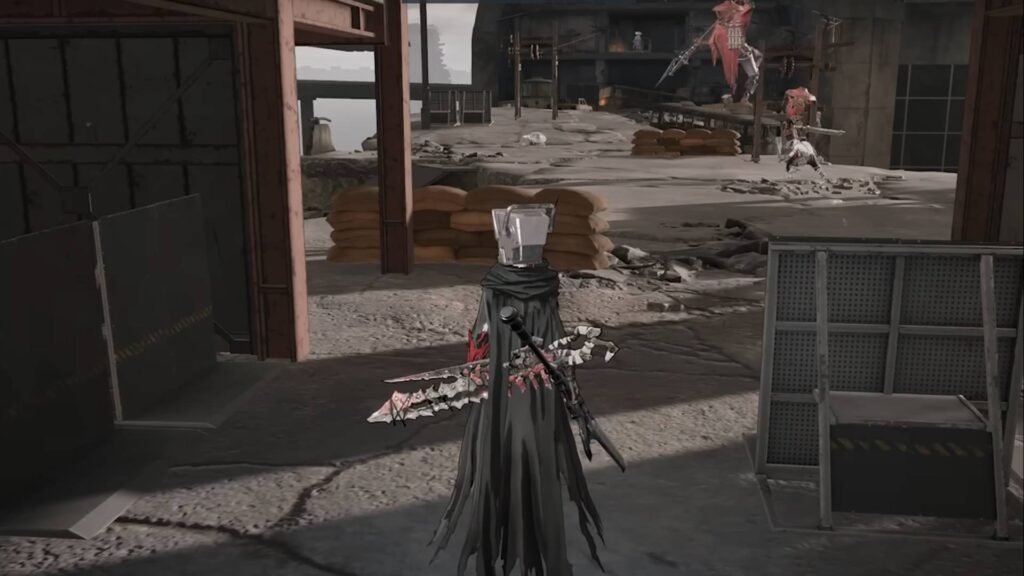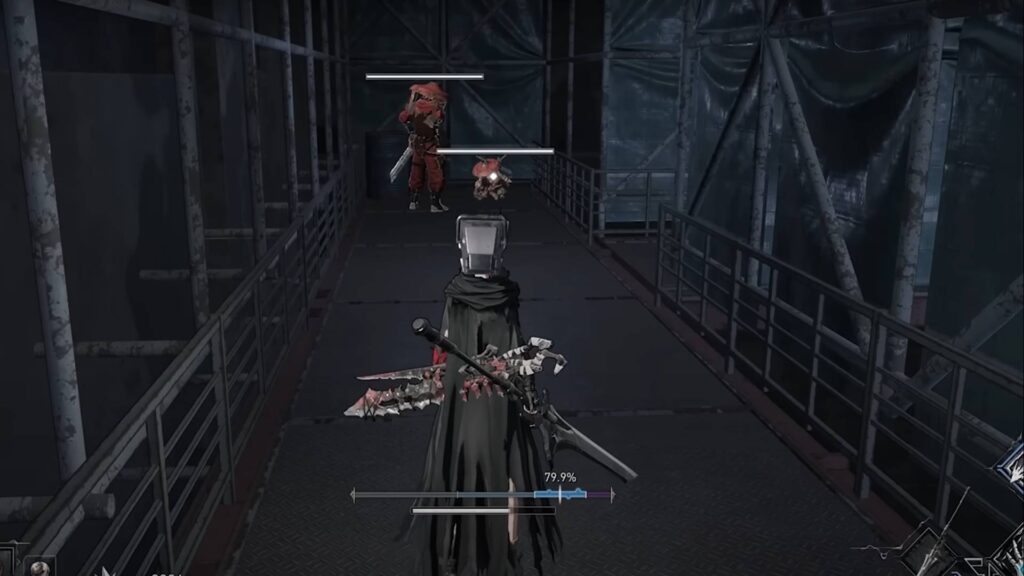AI Limit is the new $35 soulslike from Sense Games, and it kinda rocks. The game punches above its price tag in the areas that matter most, providing a deep and satisfying combat system within a soulslike structure that entertains through its 30 hour duration. But while this title certainly supplies ample value, its limited budget shows in several less crucial areas.
But first, does the game control well? It absolutely does. I don’t know if it ranks among my favorite controlling soulslikes, but it’s certainly up there among the most elastic and intuitive ones to play regarding movement. The turning radius of Arrisa’s movement is very tight and snappy and she’s a quick runner with lightning-fast attacks. There’s hardly any ‘clunk’ at all to speak of here. The camera is very well behaved during fights, though it does require manual adjustments here and there.
There are a lot of things to discuss about AI Limit, but one particular element of combat deserves frontloaded attention. That system is the Sync bar, which effectively replaces the stamina found in other titles. Unlike any other Soulslikes that I’ve encountered, AI Limit doesn’t actually have any stamina. Instead of patiently waiting for a green meter to fill back up again before sprinting, you can just sprint eternally without a care.
“AI Limit doesn’t actually have any stamina. Instead of patiently waiting for a green meter to fill back up again before sprinting, you can just sprint eternally without a care.”
You can also attack and dodge without a single thought paid to stamina. This is because AI Limit doesn’t burden basic actions behind any energy requirements; instead, advanced actions like magic and special attacks consume stamina… I mean Sync energy. I cannot emphasize enough how freeing it is just running around swinging without a single thought paid to stamina, but let’s continue.
The Sync bar itself is rather ingenious. It’s divided into tiered sections which affect your combat prowess based on what tier the bar is at. The game has nuanced terms for all these mechanics, but in general, sync rate is how fast or slow the sync energy accumulates or depletes when fighting. This kind of system encourages either type of approach: an aggressive offensive approach where you’re continually boosting sync rate akin, or a defensive one that stabilizes sync rate by avoiding hits.
There’s more packed into AI Limit’s combat that we’ll get into shortly, but let’s take a breath of fresh air and explore the multi-layered world of Havenswell. First off, no, AI Limit is not open world in any way. It’s not strictly on-rails either. The game map is structured based on district zones containing a dozen or so ‘levels’.
Each level has a handful of shortcuts that loop back to the starting Branch (your typical ‘bonfire’ in souls parlance). The map design manages to guide the player from branch to branch with a urgency while allowing some exploration with the branching paths and optional dead end areas. The level pacing hits a nice sweet spot. And those optional diversions are worthwhile most of the time, containing hidden items or quests occasionally.
Overall, the map structure is somewhat similar to Dark Souls 2, except with no dedicated hub area. Instead of a hub, the game has multiple vendors and NPCs scattered about the different districts. Thankfully, fast travel between Branches is available as soon as you reach your second Branch. Load times between warps aren’t long either, so if you find yourself returning to a grind spot to sell materials to a trader halfway across Havenswell, the process isn’t too bothersome.
The branch system is more forgiving than other soulslikes due to your currency not being lost upon death. Not all of it anyway. Only a marginal number of Crystals (your currency and experience) is lost upon death, and that amount can be adjusted based on equipment. There’s also no retrieving of lost Crystals, so that cuts down on all the backtracking to our last death that so many similar games have, and I’m thankful for that.
On the graphical front, AI Limit isn’t overtly impressive. The graphics are clearly budgeted, which shows when viewing far distant areas or objects up close – the draw distance and texture detail just aren’t that great here. There’s also not a ton of environmental props or ornamental stuff to examine, but it’s serviceable and more than makes up for it in its level design. The modest graphics don’t really translate into amazing performance either. Framerate can dip when many enemies are on screen. Turning vsync off can help with stutter and occasional input lag, but results in consistent screen tearing. It’s not a very well optimized game, but I found it perfectly manageable, but maybe that’s because I gleefully went through Blighttown on the Xbox 360 and thought that was acceptable.

“AI Limit has its fair share of bugs.”
My bigger problems had to do with some of the glitches and bugs throughout the experience. The most persistent bug I encountered made enemies invisible except the weapon they were holding. Desperately running through a street filled with floating guns to reach the next Branch wasn’t exactly a highlight of the game for me, but my bug woes don’t end there. Elements of clothing or body parts would disappear from enemies, to the point where Rayman-like heads and legs with no torso star swinging at me as if from a low budget horror game. This wasn’t game-breaking for me, but the invisible enemies did make it difficult and annoying to trudge through, despite the game’s excellent controls and combat.
Despite the lower graphical detail of AI Limit, what is graphically presented is varied. Each level is distinct, looking and feeling different from the last. The districts within Havenswell have their own challenges, giving the world an interconnection that feels lived-in.
The plot itself will be hit or miss, and it certainly isn’t cinematic in the slightest. Oh yeah, and NPCs have their own set arcs and quests. These inhabitants show up in different locations throughout your adventure and the voice acting behind most of them is surprisingly impressive. What’s more, how you interact with these characters, along with certain key decisions you make, determine one of a couple different endings.
Now let’s return to the bread and butter of AI Limit: combat. Each weapon type has a unique normal attack pattern, light Special Attack, Heavy Special Attack, and Weapon Skill. That kind of toolkit is nothing to sneeze at and it allows for some nice build variety and experimentation. But there’s something especially satisfying about the Special Attacks in particular. Special Attacks are performed with the shoulder buttons with the heavy ones requiring a windup hold. I’ve never felt as swift and ninja-like in a Soulslike quite like I do with the Dashing Slash Special Attack on the Blader Swords here. Dashing Slash performs a breezy pop-in/pop-out stab which positions your character just perfectly out of range of the enemy’s close attacks. Spamming this special attack with carefree aggression is just something you can’t do in other games, thanks to the unlimited stamina.
There’s also a ton of really cool weapon items in AI Limit. Weapon items consume a portion of the Sync Bar, dealing significant damage, occasionally with flames or poison applied. Further opening up your combat arsenal are spells. Spells really diversify the offensive toolkit with everything from a railgun projectile to homing missiles and more. But what about your defensive options? Well, defensive tactics are open to you within the Frame Abilities. Frame Abilities determine whether you want to emphasize blocking, parrying, a risk/reward berserker mode, and more. Switching between Frame modes is rather intuitive with its hotkey activation and it even shows visually with Arrisa’s arm activating.
Seals add even more tools to your arsenal with Sync bar customization. Want an ‘all or nothing’ approach to Sync Rate? Well, there’s Seals that allow that. And then there’s other ones that chop up the Sync Bar into many small energy levels to create a far more fluid and linear sync rate. Weapons and Seals can be enhanced to further their output, so it’s entirely possible to beat the game with the first seal and weapon you obtain.
The enemies you use your weapons on are no less impressive than the toolkit afforded to you. Enemies are spaced out and paced in a satisfying way. You never feel too overwhelmed by large mobs and yet always have enough stuff to fight around every corner. Early on, I got the impression that enemy variety would be lacking. I mean, how many varieties of the ghoul-like enemies can the game have? Turns out a decent amount. The game’s different factions have good variety and you’ll even stumble upon them fighting each other. Some of these faction battles allowed me to run past them on my way to the next Branch. You’ll fight poisoned flying bugs and robot drones, among many other abominations throughout the duration of the game.

“Each boss has unique attack patterns and AI behavior, as expected, but some encounters feel like a genuine test of the game’s systems.”
Oh, and the boss fights. I didn’t think I would get impressed by more soulslike boss fights, but the game even managed to surprise me there. Each boss has unique attack patterns and AI behavior, as expected, but some encounters feel like a genuine test of the game’s systems. I won’t spoil it, but a certain encounter finally made me cave in and explore a side area in hopes of obtaining better gear. After exploring multiple zones and defeating a side boss, I returned and found myself in lock-step with this tank of a robot with a giant grin on my face with tons of confidence. AI Limit’s bosses are up to the genre’s lofty standards, and I’m looking forward to fighting them with all the weapons I ignored on my first playthrough.
So is AI Limit a traditional soulslike? Yes. It’s got your post-apocalyptic setting and of course, the bonfire system is an almost 1-to-1 adaptation here. If there was any debate if this was really a soulslike, there’s even the same exact run jump from Dark Souls 1 (with no dedicated jump button, or course). But there’s a special ingredient here that makes it feel so much more fluid and freeing than all the other soulslikes, and that’s the unrestricted stamina. Having basic actions not being burdened by an energy resource is wonderful, and the game’s difficulty curve isn’t too badly affected by it, all things considered. Whether you’re a soulslike action newcomer looking for something with less friction, or are a longtime fan seeking out the next great challenge, AI Limit comes highly recommended despite its modest budget.
This game was reviewed on the PlayStation 5.














